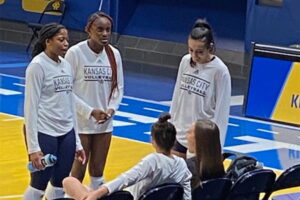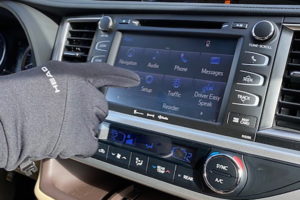Hi, we’re Rachel and Ashlee, hosts of Real Life Conversations with CapitalMom. First of all, thank you again for joining us. We always are super grateful to have you here.
Ashlee’s September Glimmer
Today, I’m going to start real quick with my glimmer, which is more of a general one. I feel like as parents and as moms, we have to make decisions that are best for our whole family, even though maybe if we only had one kid, maybe the decision would look differently, and making decisions and changes like that.
Like when we go out and we try something, and then we realize we need to make a shift or an adjustment—it’s about moving into those unknowns again. That’s something that’s hard for me. I feel a little anxious in unknowns. I like to get a feel for something, and then once I like it, to just be there, because then I know what happens and I know what to expect. And when I make a change, there’s a ton of unknowns suddenly around it. How is my kid going to react? How is the environment going to be? Is it going to be what I hope? Was it the right decision? All the questions.
Anyway, I just feel really grateful. I have been pushing through that uncomfortable period of unknowns and trying new things. I’m so proud of my kids for how they’ve been handling it, and I’m proud of myself for sticking with it even though it was really hard. If you’re in a moment in life where you have to move into something uncomfortable, to do something that’s better for your family, I I encourage all of you to just hang in there and trust your mom or dad intuition. You know best for your circumstance.
Rachel’s Game Day Glimmer
Mine is totally different. I was honestly racking my brain what I was going to say, but then, last night, we went to a Husker game, and there was this lady behind us who was probably in her late 80s. She was just the cutest lady ever. She loved my husband. I got there later than him, so when I sat down, she leaned over and goes, “He’s a cutie, isn’t he? I like him.” Later, my husband told me that she grabbed his face and kissed him on the forehead.
But this lady was just so joyful. We started talking, and she told me that her husband had just passed and that she was alone in the United States. She had moved here from England. I asked if she was at the game with her daughter, but it was her neighbor who she’d met because their dog would run away to her house and she’d feed it treats. Before we left, she told me, “I won’t be here next week because it’s my birthday, and I’m going to Omaha to go to Red Lobster.”
She was joy in human form, and I actually cannot wait to go to the next game to see her. She just reminded me that the way we interact with other people around us can have such an impact. She could have just sat there and not talked to us, and we could have not talked to her and gone about our lives. But we didn’t, and it made an impact on both of us. That’s the life lesson that I keep learning—if you have something nice to say or you feel inclined to talk to somebody, do it because it usually just brightens your day and theirs.
How to Help Your Kids Be More Inclusive
This topic came to us because our little ones have been back in school. We thought it was the perfect time to talk about this topic because maybe it’s something that your kids are experiencing right now or will experience at some point. Their attitudes are starting. In my mind, I don’t expect that to happen until middle school, but we’re so wrong. That happens younger. I’m sure it gets worse—or more intense—in middle school, but still.
Our kids are coming home, telling us different things about school, all with common themes—exclusion and lack of choice. Their friends are telling secrets, things they aren’t allowed to hear. Students at recess are playing with others but telling our kids they can’t come. Or even physically pulling our children in one direction to force them into an activity and not giving them any say or choice.
So, we want to chat about developing strategies and having those tough conversations with your kids about how to handle these situations, and how to make sure they’re not the ones making other kids feel left out. We even spoke with school counselors to further develop these thoughts.
We hope that with these suggestions, your kids will feel more empowered to handle the situation and know that you support them and want to help them through a tough situation. Obviously, as parents, we want to help them, but it’s important to draw the boundary that we’re not going to go fix it for them, unless it gets to a level that there needs to be some involvement. Instead, we want our kids to know we’ll always be a listening ear.
Use I Statements
Instead of pointing fingers at the other kid and saying, “You’re so frustrating!” or “You’re not being nice. You’re so mean,” we ask our kids to turn that around by using I statements. This empowers our kids to use their voices and say what they think. It’s not pointing fingers. It’s showing how someone else’s actions impacted them. Statements like “I feel frustrated when you won’t let me play with you” instead of “You’re being mean because you’re not letting me play with you” gives a completely different feeling to the conversation. It also teaches them to show a little vulnerability and humanity.
It also gives the other person a chance to respond to that as well, as opposed to push away, because anyone will probably get defensive if someone says “You’re being mean.” But if your kiddo says, “I’m feeling left out,” that’s very different. They know that word. They know what it means to feel sad. Those are words that kids naturally want to respond in a compassionate way toward.
Reinforce That Their Voice Matters
Just remember that your child’s voice matters, and it’s so valuable. Sometimes, kids retreat and hide and don’t say what they really think or want, while other kids maybe stand up and say not-so-kind things back. Of if your child is caught in the middle of two friends—where they feel like they want to be with both people—it’s good for them to recognize that the loudest one often gets them because they’re the ones that are speaking up more.
It’s natural to gravitate to the louder, more in-your-face personalities. You gravitate to the squeaky wheel, in a way, because many think, “Well, they obviously need me because they’re saying it so forcefully.” Eventually, though, this will help them break that cycle so that they aren’t always rewarding the loudest voice. You don’t always need to be with the loudest person in the room.
Let Them Solve Problems on Their Own…
We feel so strongly, so passionately about empowering children to know how it feels to use their voice and have it be received. That’s why we start this out at such a young age with our kids. If they’re having friction or something’s not going right, or if it’s even a playdate between our two families, Ashlee will always respond to the kids the same way when they come up and say so-and-so is doing whatever. It’s always, “Have you spoken to them about it yet?” or “Have you talked to them about it yet?” Sometimes the answer is yes, but a lot of times, it’s no.
So, then, parents can guide that conversation, like, “Hey, why don’t you ask them?” Maybe give them the words they just don’t have yet, like, “Why don’t you try ‘I was playing with that. Can I have it back, please? Maybe our moms can set a timer so that we can take turns.’?” But always let them be the ones to go deliver that message. Kids, especially at these ages, are so open to receiving messages like that, especially when it’s not done in an aggressive way. It’s amazing how quickly they can turn things around.
As parents, when it’s our kid who is feeling left out or neglected, all we want to do is fix it for them. Take away that hurt. Do I need to switch teachers? Do we need to call the mom and talk? What can I do to take away that pain? But take a step back and remember that your kid is capable, and they do have tools to use their voice. It doesn’t always have to be you scrambling to save the day. And sometimes, we can make it worse when we step in too much. Our emotions can make the situation so much bigger than it already is.
Situations where they work through something together can add to their confidence level of being capable of resolving conflict on their own, knowing that they do have the words or phrases that are now hopefully tucked away into their memory bank to help diffuse future problems. If they practice this skill at two, three or four, it’ll hopefully become second nature by the time the get to school. Because right now, it’s a toy that they want to play with or someone hurt their feelings on recess, which are such, in the grand scheme of things, small challenges to overcome and conflicts to overcome. But as they get older, those challenges are only going to get more emotional and weighted. A lot more friction is going to occur if they don’t have the tools in their toolbox to communicate in a healthy way with other people and have healthy relationships.
….Until They Can’t
That being said, if it gets to the point where they’re trying to use their words and they don’t feel like they can get where they want to be in that conversation, that’s when it’s time to bring an adult in. Obviously, if it’s our three and four-year-olds, that’s us coming in. If they’re at school, that’s their teachers or even school counselors helping out.
You’ll know when a conflict is serious. If your kid’s coming home every day crying or talking about the same person constantly or if there are changes in their behavior or mood, those are all signs that something bigger is going on. If it’s bullying or something like that that’s more severe, ask for help.
We’re both so grateful for school counselors, especially Ashlee who lost her dad back in December. When that happened, I felt unsure of how to help my kiddos when they were at school. I felt lost. And one of my kiddos especially was wanting to talk about it, but kids her age hadn’t experienced a loss like that yet. So I was able to reach out and use the school counselor as a phenomenal resource. They handled the situation so well. It helped my kid knowing that there was another adult in the school who was on their team and who knew the situation and was just there to help.
Teach Inclusion vs Exclusion
The last thing that we want to talk about—and really the whole theme of this—is to encourage more inclusion as opposed to exclusion in friendships. These are the little things that we can do to teach a much bigger principle.
We always start by asking our kids how they feel about situations. “How does it feel when you’re included? And how does it feel when you’re not included in things?” Many times, our kids are so focused on their own friends and personal lives that it’s easy to not consider others feelings in the moment. They don’t mean to be malicious, but it comes off to others as very hurtful. To go through this phase is all totally normal child development.
Then we tap into their empathy. Before they make a decision on how to act with a friend, we want them to ask themselves, “How would I feel if I was on the other side? If someone else was saying or doing what I’m saying or doing, how would I feel?”
That way, we’re teaching our kids to be the friends and the people that they want others to be for them. As they practice, they’ll more easily be able to recognize when they’re including people and when they’re not. The hope is that, then, with that awareness comes correction. If their actions could be seen as exclusionary, we hope they’ll eventually not do it.
Good luck to all parents out there who are getting similar phrases or having any experiences like this at your home with your kiddos right now. We encourage the conversations, using their words, helping them be capable, and know that we’re right there with you trying to help build a community of inclusiveness. You don’t need to do motherhood alone. Come join our village exactly as you are.

Ashlee Hendricks
Real Life Conversations Host
I am a mom to three awesome kids: Ellie, Anna, and Levi. My husband Jon works as a professor at the UNL Business College. While we are not natives to Lincoln (this year marks five years in Nebraska), I did grow up on a dairy farm in southwest Missouri and feel quite at home here. I work as a full-time mom and a part-time nurse at a clinic here in town.
As a family, we are happiest outside and having adventures. We lived in South Carolina before moving here so we’ve had to toughen up quite a bit! We love biking, camping and anything involving water. I have been supported and inspired by so many amazing women and men along my parenting journey. Rachel and I have talked a lot about our shortcomings and wins as moms. I hope as we share some of our story that you’ll find some relatable information that can nurture and inspire you wherever you are on your journey as a parent. We are all in this together!

Rachel Robinson
Real Life Conversations Host
My husband, John, is a men’s gymnastics coach at the University of Nebraska. Our kids love to go to the gym and play. We love that they now have a relationship with the college athletes. It is really fun. Go Big Red! I am very excited to be chatting about things motherhood here on CapitalMom. I hope you enjoy and are able to relate as we share our motherhood journeys.








